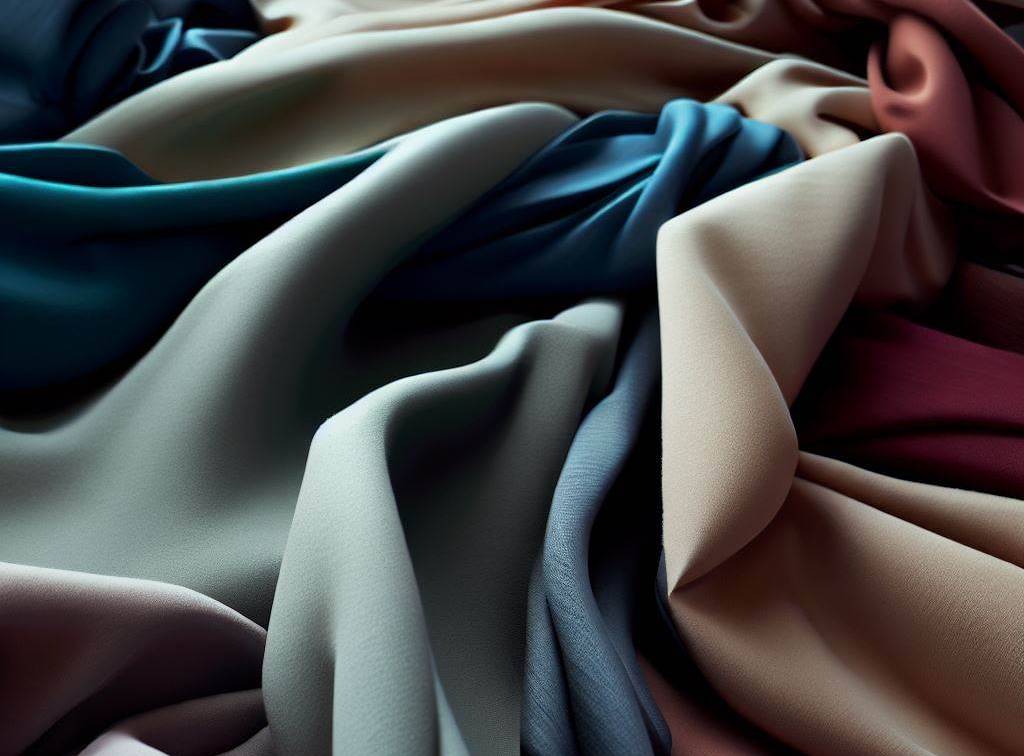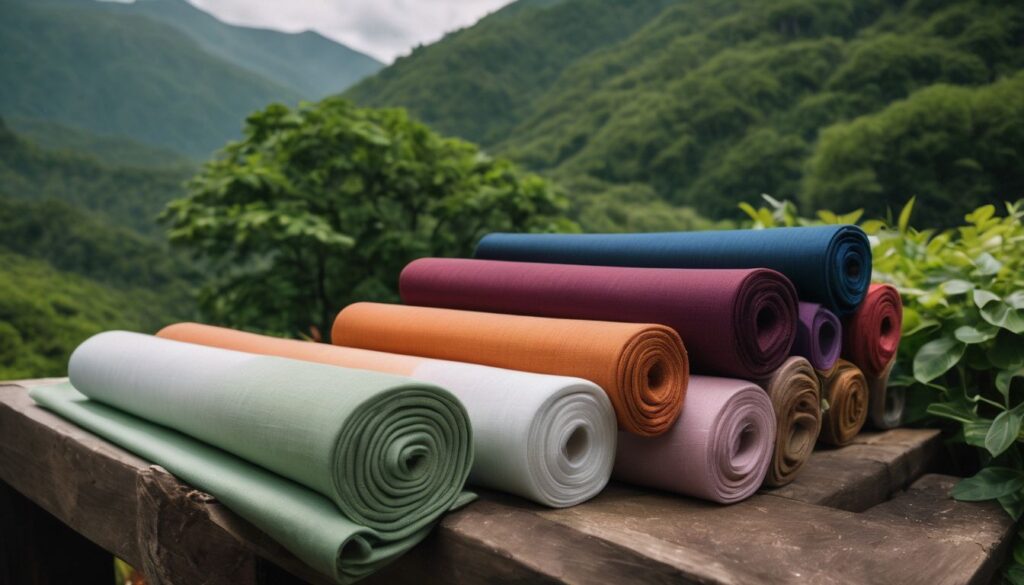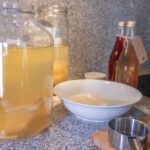Our clothes say a lot about us, but have you ever wondered what they say about our planet? Surprisingly, less than 1% of materials used in clothing production are recycled. This blog will guide you through the best sustainable fabrics for clothing, offering stylish yet eco-conscious choices.
Let’s fashion a greener future together!
Key Takeaways
- Organic cotton, recycled cotton, hemp, linen, and TENCEL™ Lyocell are eco-friendly plant-based fabrics for sustainable clothing.
- Innovative fabrics like ECONYL®, Bananatex®, Piñatex, and SCOBY leather offer unique alternatives that reduce waste and promote circular economy in the fashion industry.
- Animal – derived sustainable fabrics such as recycled wool, alpaca wool, merino wool, and peace silk provide ethical and environmentally conscious choices for clothing materials.
- Other sustainable fabric options include cork, deadstock fabrics, ECOVERO™, and cupro which contribute to a more eco-friendly fashion industry.
While the fashion industry has often been criticized for its environmental impact, from excessive water usage to waste generation, there are significant benefits to choosing sustainable clothing. These benefits not only reduce your carbon footprint but also promote ethical labor practices.
Plant-Based Sustainable Fabrics
Plant-based sustainable fabrics, such as organic cotton, recycled cotton, organic hemp, organic linen, and TENCEL™ Lyocell are eco-friendly alternatives to conventional materials and considered as the best sustainable fabrics for clothing.
Organic Cotton
Organic cotton comes from farms that take good care of our earth. They use no harsh chemicals and less water than normal cotton farms. It is safe for your skin and the soil it grows in.
Did you know organic cotton is one of the most natural fabrics? Many people like it because it’s soft, fresh, and kind to nature.
Recycled Cotton
Recycled cotton is a sustainable fabric option that helps reduce waste in the fashion industry. It is made by taking pre-consumer or post-consumer cotton scraps and converting them into new yarns or fabrics.
This process saves energy, water, and resources compared to conventional cotton production. Recycled cotton also helps divert textile waste from landfills, as less than 1 percent of clothing material is currently recycled.
By choosing recycled cotton clothing, you can contribute to a more eco-friendly and circular fashion system while still enjoying comfortable and stylish garments.
Organic Hemp
Organic hemp is a sustainable fabric that is gaining popularity in the fashion industry. It is made from the fibers of the hemp plant, which grows quickly and requires minimal water and pesticides.
This makes it an eco-friendly choice for clothing materials. Organic hemp is also known for its durability and strength, making it long-lasting and resistant to wear and tear. As a natural fiber, it offers breathability, keeping you cool in hot weather.
Additionally, organic hemp has antimicrobial properties, meaning it naturally resists odors and bacteria growth. By choosing organic hemp clothing, you are not only supporting sustainable farming practices but also investing in high-quality garments that will last for years to come.
Organic Linen
Organic linen is a sustainable fabric that comes from the flax plant. It is considered eco-friendly because it requires less water and fewer pesticides compared to conventional linen production.
In fact, organic linen uses no synthetic chemicals at all. This makes it a great choice for those who want to reduce their environmental impact.
Furthermore, organic linen is breathable and lightweight, which makes it ideal for warm weather clothing. It also has natural antibacterial properties, making it resistant to odors and easy to care for.
Additionally, organic linen is biodegradable, meaning that it will break down naturally over time without leaving behind harmful pollutants.
TENCEL™ Lyocell
TENCEL™ Lyocell is a plant-based sustainable fabric that is made from wood pulp sourced from sustainably managed forests. It is known for its softness, breathability, and moisture-wicking properties.
TENCEL™ Lyocell also requires less water and energy during production compared to conventional cotton. This eco-friendly fabric is biodegradable, making it a great choice for reducing textile waste in landfills.
Its versatility makes it suitable for various types of clothing, including activewear, loungewear, and everyday wear. With TENCEL™ Lyocell, you can enjoy both comfort and sustainability in your wardrobe choices.
Innovative Sustainable Fabrics

Some of the most innovative sustainable fabrics for clothing include ECONYL®, Bananatex®, Piñatex, and SCOBY leather.
ECONYL®
ECONYL® is an innovative and sustainable fabric that is made from 100% regenerated nylon waste. It is created by recycling materials such as discarded fishing nets, carpet fluff, and industrial plastic into a high-quality yarn.
This process helps to reduce the amount of waste in our landfills and oceans while also conserving resources. ECONYL® has the same quality and performance as virgin nylon but with a significantly lower environmental impact.
It can be used to make a wide range of clothing items, including swimwear, activewear, and accessories. By choosing ECONYL®, you are not only supporting a circular economy but also contributing to the reduction of water consumption and greenhouse gas emissions in the fashion industry.
Bananatex®
Bananatex® is an innovative sustainable fabric made from banana plant fibers. The fibers used are extracted from the stalks of banana plants that are grown for fruit production, making it a renewable and biodegradable material.
This fabric has a unique texture and is lightweight, breathable, and durable, making it suitable for various clothing items such as bags, shoes, and accessories. By using Bananatex®, we can reduce waste from the agriculture industry while also creating eco-friendly fashion products.
It’s a great choice for those looking for sustainable and natural fiber clothing options.
Piñatex
Piñatex is an innovative and sustainable fabric made from pineapple leaf fibers. It offers a cruelty-free alternative to leather while reducing waste in the agricultural industry.
Piñatex is created by extracting the fibers from pineapple leaves, which are usually discarded after harvesting the fruit. These fibers are then processed into a durable and versatile material that can be used for various applications, including clothing and accessories.
By using Piñatex, we can reduce our dependence on animal-derived materials and contribute to a more eco-friendly fashion industry.
SCOBY leather
SCOBY leather, also known as kombucha leather, is an innovative and sustainable fabric that has gained popularity in recent years. Made from a combination of bacteria and yeast called SCOBY (Symbiotic Culture of Bacteria and Yeast), this material offers a eco-friendly alternative to traditional animal-derived leathers.
The production process involves fermenting tea using the SCOBY culture, which forms a layer on top known as the “leather.” One key advantage of SCOBY leather is its biodegradability – it can break down naturally without causing harm to the environment.
Additionally, this plant-based material is cruelty-free and avoids the negative impacts associated with conventional leather production. By choosing SCOBY leather for clothing, we can contribute to reducing textile waste in landfills and promoting a more sustainable fashion industry overall.
Animal-Derived Sustainable Fabrics
Explore the world of animal-derived sustainable fabrics, such as recycled wool, alpaca wool, merino wool, and peace silk. Discover how these materials can provide eco-friendly alternatives for your clothing needs.
Read on to learn more!
Recycled Wool
Recycled wool is a sustainable fabric that helps reduce waste in the fashion industry. It is made by repurposing discarded or unused wool fibers and transforming them into new yarns for clothing production.
By recycling wool, we can prevent it from ending up in landfills, reducing textile waste and the environmental impact of the fashion industry. Recycled wool also saves energy and water compared to producing new wool, making it an eco-friendly choice.
Additionally, recycled wool maintains the same qualities as virgin wool, such as insulation and breathability. By choosing recycled wool garments, we can contribute to a more sustainable and ethical fashion industry while still enjoying high-quality clothing options.
Alpaca Wool
Alpaca wool is a sustainable fabric that comes from alpacas, which are native to the Andes Mountains in South America. Unlike conventional wool production, alpaca farming has less impact on the environment.
Alpacas have soft and warm fibers that are hypoallergenic and do not contain lanolin, making it suitable for people with sensitive skin. This natural fiber also has excellent insulation properties, keeping you warm in cold weather while being lightweight and breathable.
Additionally, alpacas have a low carbon footprint as they graze on grass rather than contributing to deforestation or environmental degradation. By choosing clothing made from alpaca wool, you can support ethically produced and environmentally conscious fashion choices.
Merino Wool
Merino wool is a sustainable fabric that comes from the Merino sheep. It is known for its softness and breathability, making it ideal for clothing. One important fact about merino wool is that it is a renewable resource because the sheep continuously grow new fleece.
The production of merino wool also has a lower impact on the environment compared to synthetic fibers like polyester. Additionally, merino wool has natural UV protection and odor-resistant properties, which makes it great for outdoor activities and sportswear.
It is important to choose merino wool and other sustainable fabrics to help reduce textile waste in landfills and minimize water consumption in clothing production.
Peace Silk
Peace silk, also known as ahimsa silk, is a type of fabric that is considered sustainable and eco-friendly. It is produced in a way that ensures the ethical treatment of silkworms.
Unlike traditional silk production where the cocoons are boiled to extract the threads, peace silk allows the silkworms to complete their life cycle and emerge from the cocoons naturally.
This means that no harm or killing occurs during the production process. Peace silk is often hand-woven by artisans and has a beautiful drape and texture. By choosing peace silk clothing, you can support cruelty-free practices in fashion while still enjoying the luxurious feel of silk.
Other Sustainable Fabrics
– Cork, a renewable and biodegradable material, is gaining popularity in sustainable fashion due to its versatility and durability.
– Deadstock fabrics, which are unused or leftover materials from other production runs, offer a sustainable option while reducing waste in the fashion industry.
– ECOVERO™ is a viscose fabric made from renewable wood sources that has a lower environmental impact compared to conventional viscose production.
– Cupro, another type of regenerated cellulose fiber, is derived from cotton linter and provides a silk-like feel without harming the environment.
Cork
Cork is another sustainable fabric that is gaining popularity in the fashion industry. It comes from the bark of cork oak trees, which can be harvested without causing harm to the tree.
Cork is lightweight, durable, and has natural insulation properties. It is also biodegradable and recyclable, making it an eco-friendly choice for clothing. Additionally, cork production helps support the preservation of cork oak forests, which are vital ecosystems for biodiversity.
By using cork fabric in clothing, we can reduce our environmental impact and promote a more sustainable fashion industry.
Deadstock Fabrics
Deadstock fabrics are a sustainable option for clothing. These fabrics refer to excess materials that were not used by manufacturers and would have otherwise ended up in landfills.
By using deadstock fabrics, we can reduce textile waste and give these unused materials a new life. Deadstock fabrics can be made from various fibers such as cotton, linen, silk, or even synthetic materials.
They offer a unique opportunity to create limited-edition garments and accessories while minimizing the environmental impact of the fashion industry. Choosing deadstock fabrics is a great way to support sustainability and promote responsible consumption in the fashion world.
ECOVERO™
ECOVERO™ is a sustainable fabric that is made from sustainably sourced wood pulp. It is produced using an environmentally friendly manufacturing process that generates less waste and emissions compared to traditional viscose production methods.
ECOVERO™ fabrics are soft, breathable, and have a silky texture, making them ideal for clothing. By choosing ECOVERO™ fabrics, we can reduce the environmental impact of fashion as they require fewer natural resources and contribute to lower water and carbon footprints.
Cupro
Cupro is a sustainable fabric made from cotton waste. It is a regenerated cellulose fiber that has a smooth and silky texture. Cupro is created by processing the cotton linter, which are short fibers attached to the seeds of the cotton plant.
These linters are usually discarded during the production of conventional cotton, but with cupro, they can be turned into usable fibers. This helps reduce textile waste and make more efficient use of resources.
Cupro also has good breathability and moisture-wicking properties, making it ideal for clothing. With its eco-friendly production process and versatility, cupro is becoming increasingly popular as a sustainable alternative in the fashion industry.
Conclusion: Best Sustainable Fabrics For Clothing You Need To Know
In conclusion, when it comes to sustainable fabrics for clothing, there are many options available. Plant-based fabrics like organic cotton, recycled cotton, hemp, linen, and TENCEL™ Lyocell are eco-friendly choices.
Innovative fabrics like ECONYL®, Bananatex®, Piñatex, and SCOBY leather offer unique alternatives. Animal-derived fabrics such as recycled wool, alpaca wool, merino wool, and peace silk are also sustainable options.
Additionally, materials like cork, deadstock fabrics, ECOVERO™, and cupro provide further environmentally conscious choices. By choosing these lower-impact textiles over conventional materials and promoting the use of recycled and upcycled fabrics in fashion production processes we can make a positive change towards toxic-free and sustainable fashion industry.
FAQs
1. What are the best sustainable fabrics for clothing?
The top eco-friendly, low-impact textiles include natural fibers like bamboo and recycled and upcycled fabrics.
2. Are all eco-friendly fabrics good for the environment?
Not all, but sustainable alternatives such as ethically made green fashion fabrics, biodegradable textile alternatives, and toxin-free textiles are good choices for the environment.
3. Can you tell me about some innovative sustainable textiles?
There are many new types of sustainable fibers being used in clothes now. This includes using old materials to make recycled fabric options or creating new ones from natural sources like plants.
4. How can I choose better materials when I buy clothes?
Look out for tags saying “made from organic clothing materials or environmentally conscious fabric” on your clothes instead of usual ones. It’s also good to go after brands that make use of lower impact materials in their products.
5. Does making use of these ecofriendly fabrics help with ethical fashion?
Yes! Making use of these ethical fashion textiles not only helps boost the quality of your wardrobe but also aids our environment by reducing waste created by fast-fashion trends.

As a dedicated mother and passionate software developer, she weaves her diverse experiences into captivating stories that inspire and engage readers. Emma's love for sustainable living and environmental consciousness permeates both her personal and professional life. When she's not immersed in the world of coding and software development, Emma can be found nurturing her family and tending to her thriving organic garden. Her commitment to sustainable practices extends to every aspect of her life, from repurposing household items to embracing eco-friendly technologies.










